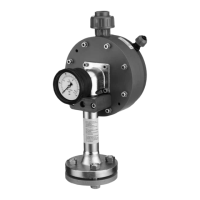English (GB)
6
2.2.7 Chlorine extraction
Before the extraction
• The chlorine containers must be stored at least for 8 hours in
the container room so that the content can adapt the ambient
temperature.
• Turn chlorine drums on the support until the dip pipe and the
riser pipe are placed vertically (observe the markings on the
drum).
• Check tightness.
Connection
• Protect containers from turning over or rolling away!
• Dry the piping and the withdrawal system with dry nitrogen or
dry air.
• No foreign matter must get into the plant.
• Mount new gaskets to the connection line.
• Connect the container.
• Slowly open the container valve.
Withdrawal of gaseous chlorine
In case of higher chlorine requirement several chlorine containers
of the same temperature have to be connected with header lines.
Withdrawal of liquid chlorine
• Within chlorination plants only possible from chlorine drums.
• Application of an evaporator is necessary.
• Withdrawal of gaseous chlorine: Observe residual pressure of
ca. 2 bar.
• Withdrawal of liquid chlorine: Observe residual pressure of ca.
4 bar.
After the extraction
• Close container valve.
• Disconnect container from the plant.
• Screw on valve protection nuts.
• Screw on protection cap.
2.3 Checking the tightness
Before commissioning check the tightness of the whole plant.
2.3.1 Checking the chlorine solution lines and the diaphragm
non-return of the injector
• Observe the manual of the injector!
2.3.2 Checking the tightness of the vacuum lines
Vacuum lines are all lines between vacuum regulator and injector.
• Close all container valves
• Close the rate valve
• Open the shut-off valve at the injection unit
• Open motive water valve
• Switch on the booster pump
• Open the rate valve
– Floater shows gas flow or vacuummeter shows more than -
9 m w. c.: Leakage in vacuum line!
• Close rate valve
• Switch off booster pump
• Close motive water valve
• Close the shut-off valve at the injection unit
• Check the vacuum lines and the connection. If necessary,
carefully re-tighten them.
• Check tightness again!
– Floater shows no gas flow, vacuummeter shows -9 m w. c.
or less: Vacuum lines are tight.
2.3.3 Checking the tightness of pressure gas lines
Pressure gas lines are all lines from the gas containers to the
vacuum regulator.
• If the plant is equipped with a nitrogen rinsing device: Check
tightness roughly with nitrogen
• Detailed checking with ammonia
Checking the tightness with nitrogen
• Close all container valves
• Open container connection valves and all shut-off valves up to
the gas dosing system
• Open the connection valve of the nitrogen cylinder
• Slowly open the valve of the nitrogen cylinder, until the lines
have a pressure of about 10 bar (read at the manometer of the
vacuum regulator).
• Apply soap water to all components under pressure
– Formation of bubbles and/or pressure drop at manometer
Leakage in pressure lines!
– Depressurize the plant!
– Eliminate leakage!
– Check tightness again!
No formation of bubbles, pressure at manometer does not drop
significantly within one hour: Pressure lines are tight.
Checking the tightness with ammonia
See chapter 5.2.3 Checking the tightness with ammonia.
Warning
Chlorine containers must never have a higher
temperature than other parts of the plant. Danger of
liquefaction and possible chlorine break-out!
At 15 °C about 1 % (DIN19607) of the content can be
withrawn per hour. In case of higher withdrawal
danger of malfunction by the formation of ice on
containers and piping!
Container size Withdrawal quantity
50 Kg 500 g/h
65 Kg 650 g/h
500 Kg 5 Kg/h
1000 Kg 10 Kg/h
Do not completely evacuate the chlorine drums.
Danger of withdrawing deposits!
Immediately close connection lines.
No moisture must get into the lines!
Warning
Do not check the tightness until the whole plant is
ready for start-up.
Danger of chlorine break-out!
More possible reasons for insufficient operating
vacuum
• injector layed out too weakly or defective
• injector obstructed
• booster pump layed out too weakly or defective
Warning
Maximum nitrogen pressure 16 bar!
Danger of damages and gas leakage when being
exceeded!

